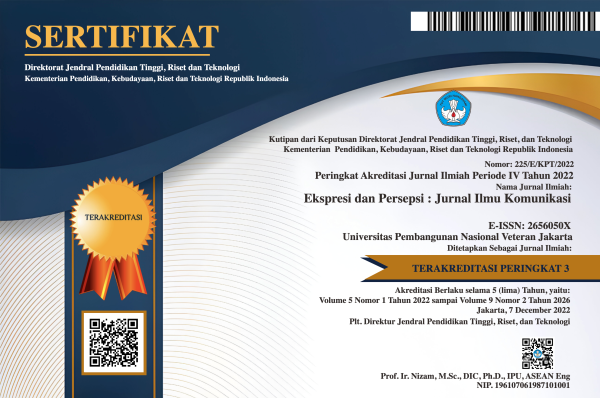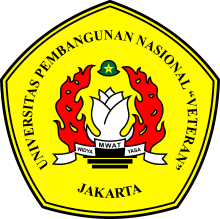Public Sentiment on Interfaith Marriage: (A Netnography Study of the Cretivox YouTube Video ‘Suami Kristen, Istri Islam’)
DOI:
https://doi.org/10.33822/jep.v7i2.7288Keywords:
controversy, communication, interfaith, marriage, netnographyAbstract
Indonesia's diversity creates opportunities for interfaith marriages. Although these marriages cannot be legally registered in Indonesia, their prevalence is increasing. This controversy stems from the belief that marriage is a private matter and shouldn't be regulated by the state. This study aims to describe public sentiment towards interfaith marriage through the Cretivox YouTube video "Suami Kristen, Istri Islam." In communication, interaction in social media, in this case commenting on YouTube videos, falls into the category of computer mediated communication (CMC). CMC theory is a type of integrable communication in which two or more people can only communicate or exchange information through a computer or referring to any kind of communication in which computer technology is used as a medium to connect individuals or groups of people to talk to each other. In research using CMC theory, Netnography is the most suitable approach where netnography is defined as a qualitative research methodology that adapts ethnographic research techniques to study the culture and community that occurs in CMC. This research found that public sentiment is generally positive, though some responses disagree. Some public argue against interfaith marriages, citing contradictions with Islamic values, while others oppose them as a precaution. Some comments shared their own interfaith marriage experiences, and some expressed hesitation or plans to enter such marriages.
References
Betlehn, A. (2022). Limitations on Interfaith Marriage Practices in Indonesia According to Human Rights Perspective. International Journal of Social Science and Human Research, 05(04). https://doi.org/10.47191/ijsshr/v5-i4-17
Briones, R., Nan, X., Madden, K., & Waks, L. (2012). When Vaccines Go Viral: An Analysis of HPV Vaccine Coverage on YouTube. Health Communication, 27(5), 478–485. https://doi.org/10.1080/10410236.2011.610258
Bruns, A., & Stieglitz, S. (2012). Quantitative Approaches to Comparing Communication Patterns on Twitter. Journal of Technology in Human Services, 30(3–4), 160–185. https://doi.org/10.1080/15228835.2012.744249
CNN. (2018). Youtube Jadi Aplikasi Media Paling Populer di Indonesia. https://www.cnnindonesia.com/teknologi/20180406202852-213-288967/youtubejadi-aplikasi-media-paling-populer-diindonesia
Erwinsyahbana, T. (2019). Aspek Hukum Perkawinan Antar Agama Dan Problematika Yuridisnya. Refleksi Hukum: Jurnal Ilmu Hukum, 3(1), 97–114. https://doi.org/10.24246/jrh.2018.v3.i1.p97-114
Fan, W., & Gordon, M. D. (2014). The Power of Social Media Analytics. Communications of the ACM, 57(6).
Jaspal, R., Turner, A., & Nerlich, B. (2014). Fracking on YouTube: Exploring Risks, Benefits and Human Values. Environmental Values, 23(5), 501–527. https://doi.org/10.3197/096327114X13947900181473
Katadata. (2019). Youtube Medsos No 1 di Indonesia. https://katadata.co.id/infografik/2019/03/0 6/youtube-medsos-no-1-di-indonesia
Khan, M. L. (2017). Social media engagement: What motivates user participation and consumption on YouTube? Computers in Human Behavior, 66, 236–247. https://doi.org/10.1016/j.chb.2016.09.024
Kiousis, S. (2002). Interactivity: a concept explication. New Media & Society, 4(3), 355–383. https://doi.org/10.1177/146144480200400303
Kozinets, R. (2010). Netnography: Doing Ethnographic Research Online. Sage Publication.
McMillan, S. J. (2002). Exploring Models of Interactivity from Multiple Research Traditions: Users, Documents, and Systems. In Handbook of New Media: Social Shaping and Consequences of ICTs (pp. 163–182). SAGE Publications, Ltd. https://doi.org/10.4135/9781446206904.n13
Molyneux, L. (2018). Mobile News Consumption. Digital Journalism, 6(5), 634–650. https://doi.org/10.1080/21670811.2017.1334567
Nandapratiwi, Z. A., Nugraheni, A. S. C., & Maharani, A. E. P. (2022). A Juridical Analysis of Abroad Interfaith Marriage’s Position in Indonesia’s Law. Interdisciplinary Social Studies, 1(10), 1242–1249. https://doi.org/10.55324/iss.v1i10.230
Nasir, M. A. (2022). Negotiating Muslim Interfaith Marriage in Indonesia: Integration and Conflict in Islamic Law. Mazahib, 21(2), 155–186. https://doi.org/10.21093/mj.v21i2.5436
Obadimu, A., Mead, E., Hussain, M. N., & Agarwal, N. (2019). Identifying Toxicity Within YouTube Video Comment (pp. 214–223). https://doi.org/10.1007/978-3-030-21741-9_22
Nedumkallel, J. P. (2020). Interactivity of Digital Media. International Journal of Interactive Communication Systems and Technologies, 10(1), 13–30. https://doi.org/10.4018/IJICST.2020010102
Pratama, R. B. (2022). Nikah Beda Agama Ternyata Paling Banyak Terjadi di Surakarta, Kok Bisa?. https://kumparan.com/kumparannews/nikah-beda-agama-ternyata-paling-banyak-terjadi-di-surakarta-kok-bisa-1yryRUvdrtg/full
Puspita, R., & Suciati, T. N. (2020). Mobile Phone dan Media Sosial: Penggunaan dan Tantangannya pada Jurnalisme Online Indonesia. Ekspresi Dan Persepsi : Jurnal Ilmu Komunikasi, 3(2), 132–146. https://doi.org/10.33822/jep.v3i2.1781
Puspitasari, R. D. (2024). ‘Ribetnya’ Pernikahan Beda Agama, Bukti Negara Campuri Urusan Privat. Konde.Co. https://www.konde.co/2024/05/ribetnya-pernikahan-beda-agama-bukti-negara-campuri-urusan-privat/
Quiring, O., & Schweiger, W. (2008). Interactivity: A review of the concept and a framework for analysis. Comm, 33(2), 147–167. https://doi.org/10.1515/COMMUN.2008.009
Sanjaya, M. L. T., & Nasvian, M. F. (2024). Interaktivitas Netizen 24 Jam Pasca Deklarasi Bacapres AMIN. Ekspresi Dan Persepsi : Jurnal Ilmu Komunikasi, 7(1), 106–122. https://doi.org/10.33822/jep.v7i1.7169
Saputra, A. (2023). PN Jakut Izinkan Nikah Beda Agama Pasca-SEMA, Ini Sikap MA . Detik.Com. https://news.detik.com/berita/d-6902148/pn-jakut-izinkan-nikah-beda-agama-pasca-sema-ini-sikap-ma
Thelwall, M. (2018). Social media analytics for YouTube comments: potential and limitations. International Journal of Social Research Methodology, 21(3), 303–316. https://doi.org/10.1080/13645579.2017.1381821
Wen Li, W., Hodgetts, D., & Foo, K. H. (2018). Asia-Pacific Perspectives on Intercultural Psychology (W. W. Li, D. Hodgetts, & K. H. Foo, Eds.). Routledge. https://doi.org/10.4324/9781315158358
Yacob, R. (2019). Penggunaan Bahasa Pada Kolom Komentar Di Youtube: Studi Kajian Awal. Seminar Bahasa Dan Sastra Indonesia, 2(1).
Downloads
Published
Issue
Section
License
Copyright (c) 2024 Anastasia Winanti Riesardhy

This work is licensed under a Creative Commons Attribution-NonCommercial 4.0 International License.














